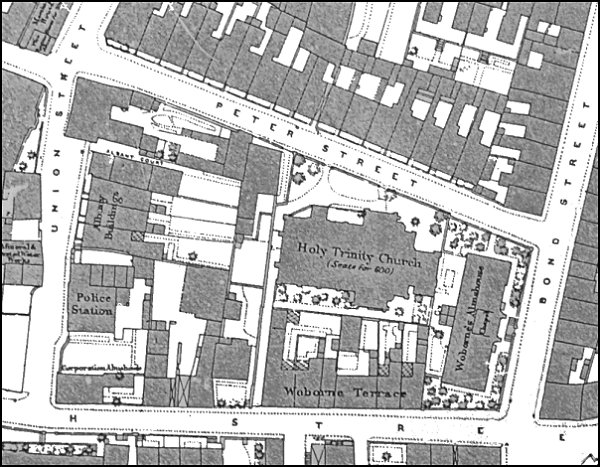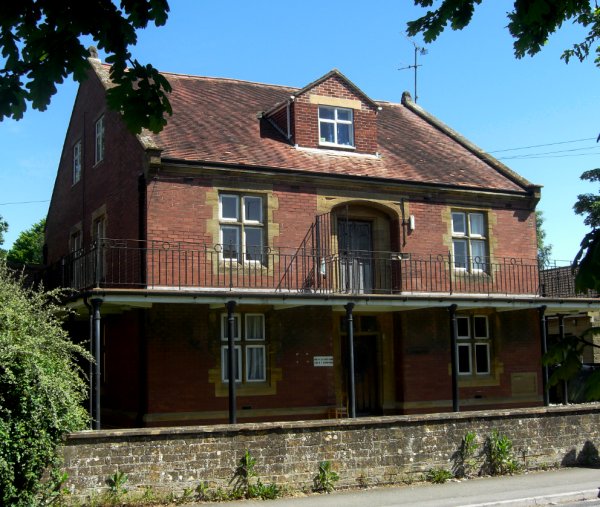portreeve's almshouse
portreeve's almshouse
South Street
The Portreeve’s
Almshouse,
variously
known as the
Poor Almshouse,
the Back Street
Almshouse, Wine
Street Almshouse or the
Corporation
Almshouse, was
situated on land
now occupied by
the car park of
the
Town House
on the corner of
Union Street and
South Street.
The almshouse
was originally
established by,
and later
mentioned in the
1416 will of, John
Stone, Rector of
Tintinhull. In
his will he stated
"to each poor
person now in
the almshouse of Yevele 6s 8d"
with any residue
after other
bequests had
been honoured
intended for
"the maintenance
of the poor in
the almshouse of
Yevele lately
founded". An
endorsement on a
deed relating to
Stoford property
records that it
was the rector
himself who had
founded the
almshouse. The
almshouse had a
small garden to
its immediate
east.
In his will dated 15 January 1592, John Hacker wrote "... Item I give and bequeath unto the poore people of the Almeshouse latelye edified in the South streate of yeven aforesayd fower shillinges to be payde fower pence by the weeke by my sayde Executrixe... ".
The Portreeve's Almshouse was managed for over two hundred years by the Portreeve and Burgesses of the old corporation. In 1669 their accounts recorded that the three elderly women living in the almshouse were each given 4d a week (which remained the standard rate until 1854) and they also received a few extra pennies at special occasions.
Monies were also expended on property maintenance, such as in 1736 when 4d was spent on cleaning the almshouse chimneys and John Churchouse was paid two shillings for "work, labour and nails about the Bogg-house". In 1773 the Portreeve and Burgesses' traditional Christmas feast was cancelled as the money was required for urgent repairs to the almshouse.
Mismanagement and misappropriation of charity funds of the Portreeve's Almshouse was part the Yeovil Charities Scandal.
The origins of the Portreeve's Almshouse was outlined in 1820 in the House of Commons where a report by the Church Commissioners into Yeovil's charities was discussed - "This almshouse was probably established, as its name seems to denote, by the portreeve, or by the portreeve and burgesses of Yeovil (now proven to be incorrect). We have not been able to discover that its inmates have any other claim upon the funds of the corporation for their support, except the presumption arising from an unvaried and long continued payment."
It was occupied by four poor single women who were originally appointed by the Portreeve and Burgesses as vacancies occurred, but management of the almshouse was taken over by the Municipal Borough when it was formed in 1854. Each inmate had a separate bedroom and shared a large sitting room.
Vickery, using the above House of Commons discussion as a source, wrote in 1856 “The sum of £2 18s has been annually paid out of the town rents, since the year 1733, to the inmates of this Almshouse” and it is recorded that the building was repaired in 1773 but, to meet the expense, no annual ‘feast’ was held that year. Other payments made include 4d for sweeping the chimneys and 1s 6d for work carried out in the gardens. The corporation paid 4d a week to each of the four poor women and on New Year's Day, Good Friday, Whitsunday, and Christmas Day they received an extra 4d each. Also at Christmas they shared four loaves of bread, twelve pounds of beef, and one shilling for beer.
According to Vickery “On the 17th January, 1814, a petition, under the 52 Geo. III, c. 101, in the names of several of the poor women inhabiting the Almshouse against the Portreeve and Burgesses, was presented to the Lord Chancellor, by the direction of Mr George Watts and others, complaining of the misapplication of the trust property. The petition was heard by the Master of the Rolls, on the 16th Feb, 1814, and by him referred to a Master in Chancery. In May 1815, all the deeds and documents belonging to the Corporation were left at the Master's office; but in May, 1817, upon application, they were received back from London. No further steps towards the enforcement of this petition have ever been taken. No document has ever been discovered tending to show the origin or foundation of this Almshouse”.
In 1835 the Portreeve's Almshouse was completely rebuilt, costing over £500 which included the rent for temporary accommodation for the four poor women during the rebuilding works. The Portreeve at the time was Robert Jennings who made a claim against the Corporation in the sum of £436, having already paid the contractor's bill for the rebuilding of the Almshouse. When payment was not forthcoming Jennings took it upon himself to advertise the sale of some corporation property. An injunction was brought against Jennings by George Wellington, a Burgess and former Portreeve, to prevent the sale.
In the 1851 census it was called the Wine Street Almshouse and five elderly women lived there. They were all described as 'inmates and alms receivers' as well as their former occupations; three glovers, a charwoman and a servant.
In the 1861 census the almshouse itself was not named but was listed in Wine Street. The four elderly residents were more graciously described as 'in Alms House' alongside their former occupations; house servant, glove maker, farm labourer and washer woman.
The 1871 census listed the establishment as the South Street Almshouse with a 'Master' and four 'Inmates'. The master was actually the youngest 'inmate' aged 55 and all five had their former occupations listed; dressmaker, two schoolmistresses and two glove sewers.
In the 1881 census the establishment was named as the Union Street Corporation Almshouse in which lived 75-year old Sarah Goodland, the Matron, and four women aged between 70 and 83 and each being listed as a “Pauper & Inmate of the Almshouse”.
It was again referred to as the Corporation Almshouse in 1891, with Sarah Hayward as Matron and six 'Inmates of Almshouse' resident.
In the 1901 census, the final listing of the establishment, it was referred to as the Corporation Almshouse and had 48-year old Eliza Symes as the resident 'Matron of Corporation Almshouse' together with six elderly resident 'inmates'.
The Portreeve's Almshouse burnt down in 1910 and a new site was chosen in Preston Grove where Dorcas House was built. It was modernised in the 1980’s and converted into seven self-contained flats specifically for women, especially young mothers and mothers-to-be. It also occasionally provides temporary accommodation for homeless women.
MAP

Map based on the 1886 Ordnance Survey showing the Portreeve's Almshouse, called the Corporation Almshouse on the map, at bottom left on the corner of Union Street and South Street.
Gallery

Dorcas House, Preston Grove - legacy of the Portreeve's Almshouse. Photographed 2013.